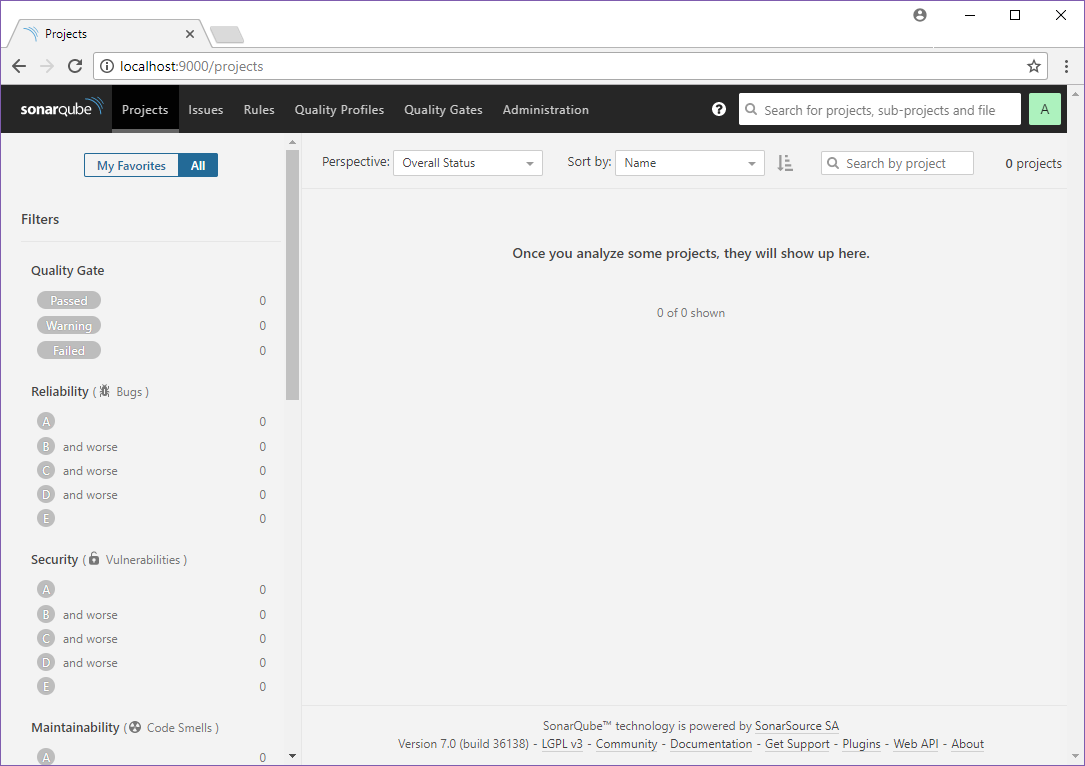In this post I will explain all the steps I follow to install SonarQube in a Windows (Windows 10) environment. Windows Server steps should be the same except from resources location. You should surely connect to a remote database server, needs to configure remote access on that server. Also make the SonarQube server available outside (enable TCP port) etc. Most of the steps like configure it as a Windows service are explained in this post.
Requirements
SonarQube needs two main requirements: Java and a supported Database. In my case I have a SQL Server Express 2017 (14.0.1000) instance. But no Java installed, so I will go first with the download and setup of Java and then create a database.
Java Installation
At the moment of this write the latest version of SonarQube is 7.0 and it only supports Java 8. https://docs.sonarqube.org/display/SONAR/Requirements
We can download the latest JDK from the official site http://www.oracle.com/technetwork/java/javase/downloads/index.html the current latest version is JDK 8u162.
The download file is a tar.gz with a jdk1.8.0_162 folder inside. You can open and extract it with most compression tools like 7-zip.

Copy the extracted folder to a any folder in you hardrive, like: C:\, C:\Java, etc. Personally I don’t like spaces in the path like “C:\Program Files\Java” but there is no restriction there.
Once you extracted the folder we have to configure some environment variables. In order to do that we need to open the System Properties Window. Control Panel > System and Security > System or just type control system in a console window.
Then go to Advanced system settings (another quick way, maybe the quickest way, is to type sysdm.cpl in a console window)
In the System Properties window go to the Advanced tab > Environment Variables button
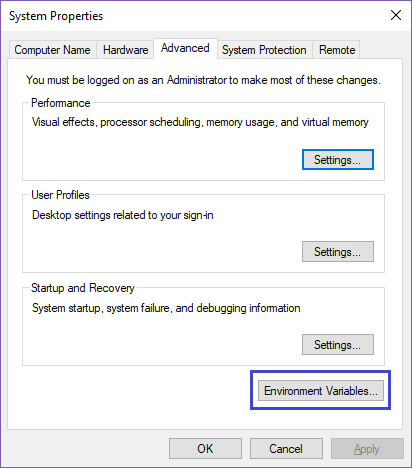
Add the JAVA_HOME variable configured with the path to the JDK folder, for example: C:\java\jdk1.8.0_162. Also for convenience we can add the bin folder to the Windows PATH environment variable. Following our example: C:\java\jdk1.8.0_162\bin that will allow us to run java at any console window just by type java
Once we completed those steps we should be ready to test the installation. Open a console window cmd.exe or Windows key + I or A and type
java -version
we should something similar to the screenshot
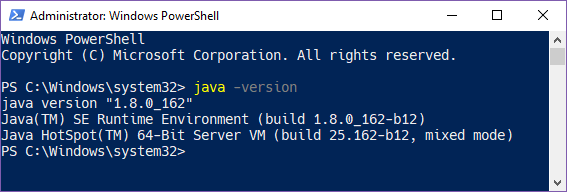
Also we can test the JAVA_HOME environment variable by running
echo %JAVA_HOME%
In a console Window (cmd.exe) or:
$env:JAVA_HOME
In a powershell window
In both cases you should see the configured path.
SQL Server Database
Assuming that you already have a SQL Server instance installed (which is my case) the only step left is to create the database and user.
First we will create the database. You can name it wherever you want, in my case sonarqube the minimum things that you need to take into account are the collation and compatibility level
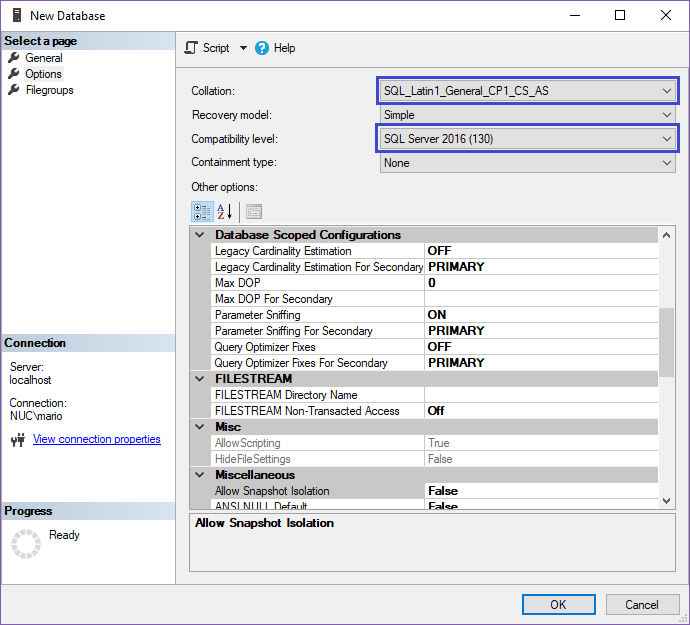
The collation must be case-sensitive (CS) and accent-sensitive (AS) for example: SQL_Latin1_General_CP1_CS_AS
About the compatibility level, since I have installed an instance of SQL Server Express 2017 and the current version of SonarQube only supports SQL Server 2014 or 2016 I need to explicitly configure it with one of the supported versions.
The following steps are to create the user. This is not mandatory but recommended. In my case I have created a sonarqube user and map it to the sonarqube database and DB Owner.
From SQL Server Management Studio: Security > Logins > New Login and then on User Mappings you can setup the db_owner database role membership.
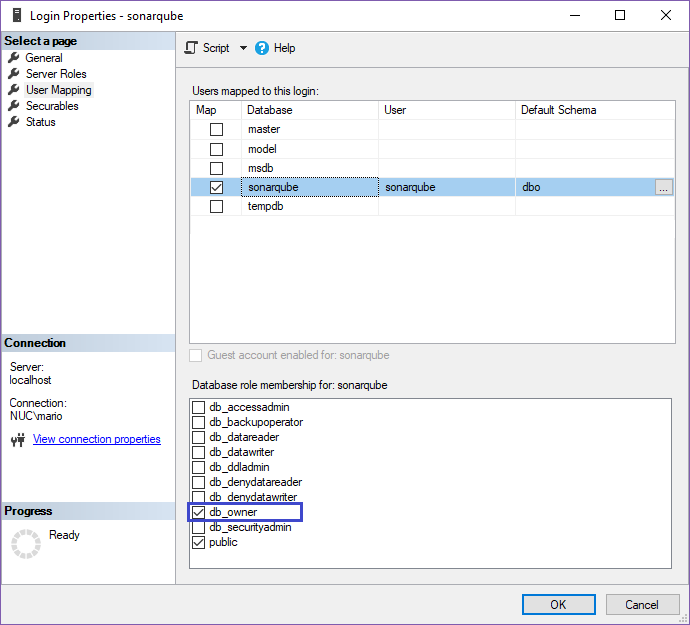
Download SonarQube
With all the previous steps executed already we are ready to install SonarQube. First we have to download it from the official site: https://www.sonarqube.org/#downloads. At the moment of this write the latest version is 7.0.
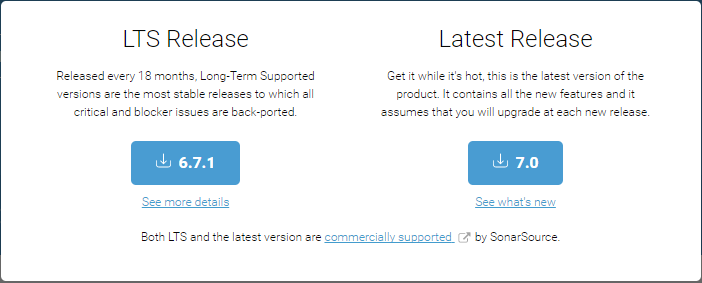
The installation basically consist on the extraction of the sonarqube-7.0 folder in a specific folder like: C:\sonarqube
After we extract the folder we have to configure SonarQube with our database connection string, user and password.
In order to do that we have to edit the sonar.properties file [install_directory]/conf/sonar.properties
Uncomment and Configure:
sonar.jdbc.username=[sonarqube-db-user]
sonar.jdbc.password=[sonarqube-db-password]
In our example the db user is
sonarqube
Also uncomment and configure the SQL Server Section
sonar.jdbc.url=jdbc:sqlserver://[dbhost];databaseName=[sonar-db];instance=[instance-name]
For example sonar.jdbc.url=jdbc:sqlserver://localhost;databaseName=sonarqube The instance is only required if you don’t use the default SQL Server instance: MSSQLSERVER
Configure to run as a Windows Service
This step is completely optional. You can always run SonarQube from any console window by running:
%SONARQUBE_HOME%/bin/windows-x86-[X]/StartSonar.bat
But if you want to configure it as a Windows service (recommended in a server installation). You can do it by opening a console window as an administrator and run:
%SONARQUBE_HOME%/bin/windows-x86-[X]/InstallNTService.bat
You should get and output similar to:
wrapper | SonarQube installed.
Then you can open the Services console (running services.msc from a console window for example) and validate that the SonarQube service is installed (and stopped at the moment)
Another optional step is to change the default service Log on account from Local System Account to a specific user account for SonarQube. This will allow for example to have more granularity at the file system access rights. But maybe have more sense when we are configuring SonarQube in a server.
Another thing to take into account is in order to be able from SonarQube to connect to the DB server, TCP/IP and remote access needs to be enabled in SQL Server.
For external access you need to enable tcp port 9000 in your firewall.
SonarQube
That’s it. With all the previous steps executed you should be able to navigate to http://localhost:9000
And login to the application as an administrator with the default admin credentials:
User=admin
Password=admin
